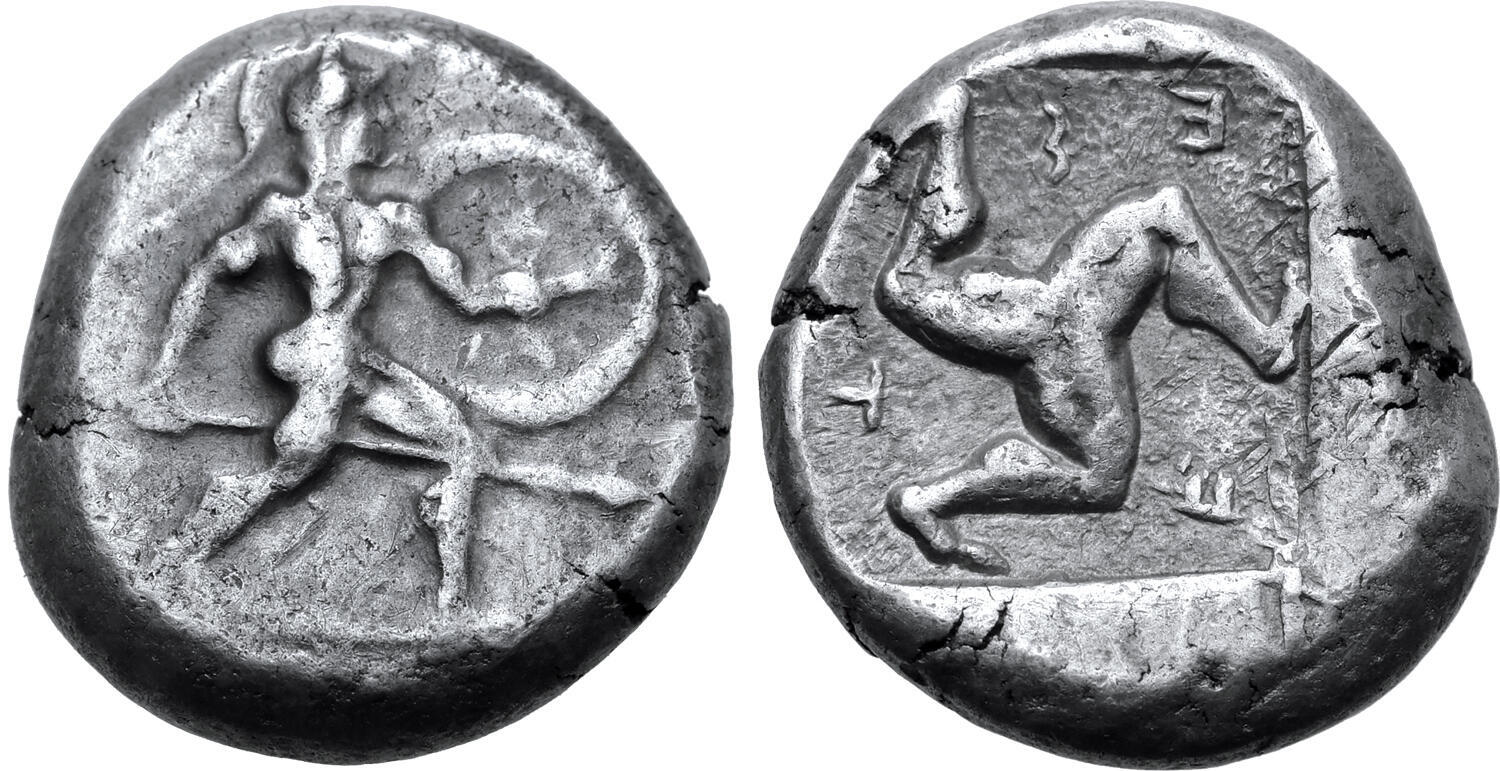2420 - Side (double siglos pomegranate/Athena) over Aspendus (hoplite/triskeles) (Nomos, 19, Nov. 2019, 170)
From SILVER
460 BCE - 450 BCE
Location/history
| Sale(s)Sale(s) ᵖ: | Nomos, 19, 17 Nov. 2019, 170 | |
Overstriking coin
Description
| ObverseInscription or printing placed on the obverse.: | Pomegrenate on a stern with leafs. | ReverseInscription or printing placed on the reverse.: | Head of Athena right, wearing crested Attic helmet. Il right field, dolphin. All within incuse square. |
Mint and issuing power
| MintIdentifies the place of manufacture or issue of a numismatic object.: | Side | Ancient regionAncient region. | Pamphylia | Modern countryModern country: Turkey | AuthorityIdentifies the issuing power. The authority can be "pretended" when the name or the portrait of X is on the coin but he/she was not the issuing power. It can also be "uncertain" when there is no mention of X on the coin but he/she was the issuing power according to the historical sources: | Persian Empire |
Chronology
| FromIdentifies the initial date in a range assigned in a numismatic context. 460 BCE toIdentifies the final date in a range assigned in a numismatic context.. 450 BCE | Classical 480-323 BC |
Physical description
| MetalThe physical material (usually metal) from which an object is made.: Silver |
WeightWeight of the numismatic object (in grams). in grams: 10.7710.77 g <br />10,770 mg <br /> | DenominationTerm indicating the value of a numismatic object. Examples: tetradrachm, chalkous, denarius.: double siglos |
AxisDescribes the directional relationship between the obverse and reverse of a numismatic object.: 1212 mm <br />1.2 cm <br /> |
| DiameterDescribes diameter of an object (in mm).: 2121 mm <br />2.1 cm <br /> | StandardStandard.: Persian | ||
References
| Coin referenceReference of the Coin: | Coin series referenceReference to coin series study: | Atlan 19671Atlan 1967, II.10 | |
| Coin series web referenceCoin series web references: | |||
Overstruck type
Description
| ObverseInscription or printing placed on the obverse.: | Warrior walking right, naked, wearing helmet, holding spear in right hand, shield attached on left arm. | ReverseInscription or printing placed on the reverse.: | ΕΣΤ (Greek) Triskeles of human legs. All within incuse square. |
Mint and issuing power
| MintIdentifies the place of manufacture or issue of a numismatic object. ᵖ: | Aspendus | Ancient regionAncient region. ᵖ | Pamphylia | Modern countryModern country: Turkey | AuthorityIdentifies the authority in whose name (explicitly or implicitly) a numismatic object was issued. ᵖ: | Persian Empire |
Chronology
| FromIdentifies the initial date in a range assigned in a numismatic context. 466 BCE toIdentifies the final date in a range assigned in a numismatic context.. 430 BCE | Classical 480-323 BC |
Physical description
| DenominationTerm indicating the value of a numismatic object. Examples: tetradrachm, chalkous, denarius. ᵖ: | double siglos |
StandardStandard. ᵖ: | Persian |
References
| Coin type referenceReference to coin series study ᵖ: | Babelon 19012Babelon 1901, Part 2, Tome 1, p. 526-530, n° 869-70, SNG von Aulock Pamphylien3SNG von Aulock Pamphylien, n° 4482-83, SNG France 34SNG France 3, n° 12-13 | ||
| Coin series web reference overstruckCoin series web references overstruck: | |||
Additional data
| Frequency of overstrikesFrequency of overstrikes: | rare and concentrated | Level of confidenceLevel of confidence of the identification: | sure |
| RemarksRemarks: | "overstruck on an Aspendos stater. Until now, this series has been dated to between 479 and 460 BC, primarily because of the particularly late-Archaic-looking head of Athena on the reverse. The present coin requires to revise that chronology since it is definitely overstruck on a stater of Aspendos, dated independently to c. 465 - 430! On the coin's obverse the undertype is that of a helmeted warrior striding to left, holding a spear and shield (traces of the warrior's body are visible on the pomegranate when the coin is inverted); on the reverse are traces of the undertype of a triskeles in an incuse square (one leg is visible on the cheek of Athena). If we accept that the earlier and cruder types of the Aspendian series with the warrior and the triskeles have to be dated to c. 465-440, the coin of Side we have here, which is stylistically very close to all the other known examples of this early type, cannot be dated before 460 BC. Thus we can suggest that this series ought to be dated to 460-450 BC; thus, we have to downdate the beginning of the next period of the coinage of Side." | ||
References
- ^ Atlan, Sabahat (1967), Untersuchungen über die sidetischen Münzen des V. und IV. Jahrhunderts v. Chr., Ankara, 181 p., 12 pl.
- ^ Babelon, Ernest (1901), Traité des monnaies grecques et romaines. Tome Premier. Première partie, théorie et doctrine, Paris, E. Leroux
- ^ Sylloge Nummorum Graecorum. Sammlung v. Aulock. Pamphylien. 11 Heft (n° 4477-4893), Berlin, 1965.
- ^ Levante, Edoardo [with the collaboration of Peter Weiss] (2001), Sylloge nummorum graecorum. France. 3, Département des monnaies, médailles et antiques : Pamphylie, Pisidie, Lyaconie, Galatie, Paris-Zürich, Bibliothèque nationale de France-Numismatica Ars Classica, XXXIV + 293 p. and 146 pl.

